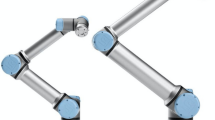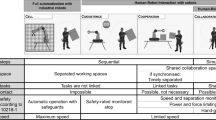Abstract
Collaborative industrial robot (cobot) systems are deployed to automate tasks or as a tool for Human-Robot Interaction (HRI) scenarios, especially for manufacturing applications. A large number of manufacturers of this technology have entered the cobot market in recent years. Manufacturers intend to offer easy control possibilities to make cobots suitable for different user groups, but there are few evaluation tools for assessing user interface (UI) design specifically for cobots. Therefore, we propose a set of design guidelines for cobots based on existing literature on heuristics and cobot UI design. The guidelines were further developed on the basis of modified heuristic evaluations by researchers with robotics expertise, as well as interviews with cobot UI/User Experience (UX) design experts. The resulting design guidelines are intended for identification of usability problems during heuristic evaluation of the UI design of cobot systems.
Access this chapter
Tax calculation will be finalised at checkout
Purchases are for personal use only
Similar content being viewed by others
References
Adamides, G., Christou, G., Katsanos, C., Xenos, M., Hadzilacos, T.: Usability guidelines for the design of robot teleoperation: a taxonomy. IEEE Trans. Human-Mach. Syst. 45(2), 256–262 (2015). https://doi.org/10.1109/THMS.2014.2371048
Amershi, S., et al.: Guidelines for human-AI interaction. In: Proceedings of the 2019 CHI Conference on Human Factors in Computing Systems - CHI ’19, pp. 1–13. ACM Press (2019). https://doi.org/10.1145/3290605.3300233
Bangor, A., Kortum, P.T., Miller, J.T.: An empirical evaluation of the system usability scale. Int. J. Hum.-Comput. Interact. 24(6), 574–594 (2008). https://doi.org/10.1080/10447310802205776
Bladford, A.: Semi-structured qualitative studies. In: The Encyclopedia of Human-Computer Interaction. The Interaction Design Foundation, 2 edn. (2013). https://www.interaction-design.org/literature/book/the-encyclopedia-of-human-computer-interaction-2nd-ed/semi-structured-qualitative-studies
Clarkson, E., Arkin, R.C.: Applying heuristic evaluation to human-robot interaction systems, American Association for Artificial Intelligence (2007)
drag&bot: Industrieroboter wie ein smartphone bedienen (2020). https://www.dragandbot.com/de/. Accessed 10 Sept 2020
El Zaatari, S., Marei, M., Li, W., Usman, Z.: Cobot programming for collaborative industrial tasks: an overview. Robot. Auton. Syst. 116, 162–180 (2019). https://doi.org/10.1016/j.robot.2019.03.003
Ferraguti, F., Pertosa, A., Secchi, C., Fantuzzi, C., Bonfè, M.: A methodology for comparative analysis of collaborative robots for Industry 4.0. In: 2019 Design, Automation Test in Europe Conference Exhibition (DATE), pp. 1070–1075 (2019). https://doi.org/10.23919/DATE.2019.8714830
Fletcher, S.R., Johnson, T.L., Larreina, J.: Putting people and robots together in manufacturing: are we ready? In: Aldinhas Ferreira, M.I., Silva Sequeira, J., Virk, G.S., Tokhi, M.O., Kadar, E.E. (eds.) Robotics and Well-Being. ISCASE, vol. 95, pp. 135–147. Springer, Cham (2019). https://doi.org/10.1007/978-3-030-12524-0_12
Franka Emika GmbH: Franka Emika Panda (2020). https://www.franka.de/technology
Hoffman, G., Zhao, X.: A primer for conducting experiments in human-robot interaction. ACM Trans. Hum.-Robot Interact. 10(1), 1–31 (2020). https://doi.org/10.1145/3412374
Ionescu, T.B., Schlund, S.: A participatory programming model for democratizing cobot technology in public and industrial fablabs. Procedia CIRP 81, 93–98 (2019). https://doi.org/10.1016/j.procir.2019.03.017
ISO: ISO 9241–210 Ergonomics of human-system interaction - Part 210: Human-centred design for interactive systems (2010). https://www.sis.se/api/document/preview/912053/
ISO: ISO/TS 15066:2016(en) Robots and robotic devices - Collaborative robots (2016)
Komenda, T.: SAMY - semi-automatische modifikation (2020). https://www.fraunhofer.at/de/forschung/forschungsfelder/SAMY.html. Accessed 10 Sept 2020
Krot, K., Kutia, V.: Intuitive methods of industrial robot programming in advanced manufacturing systems. In: Burduk, A., Chlebus, E., Nowakowski, T., Tubis, A. (eds.) ISPEM 2018. AISC, vol. 835, pp. 205–214. Springer, Cham (2019). https://doi.org/10.1007/978-3-319-97490-3_20
KUKA AG: LBR iiwa (2020). https://www.kuka.com/en-de/products/robot-systems/industrial-robots/lbr-iiwa
Lupetti, M.L., Zaga, C., Cila, N.: Designerly ways of knowing in HRI: broadening the scope of design-oriented HRI through the concept of intermediate-level knowledge. In: Proceedings of the 2021 ACM/IEEE International Conference on Human-Robot Interaction. pp. 389–398. ACM, Boulder (2021). https://doi.org/10.1145/3434073.3444668. https://dl.acm.org/doi/10.1145/3434073.3444668
Malik, A.A., Bilberg, A.: Developing a reference model for human–robot interaction. Int. J. Interact. Design Manuf. (IJIDeM) 13(4), 1541–1547 (2019). https://doi.org/10.1007/s12008-019-00591-6
Marvel, J.A., Bagchi, S., Zimmerman, M., Antonishek, B.: Towards effective interface designs for collaborative HRI in manufacturing: metrics and measures. ACM Trans. Hum.-Robot Interact. 9(4), 1–55 (2020). https://doi.org/10.1145/3385009
Maurice, P., Allienne, L., Malaise, A., Ivaldi, S.: Ethical and Social Considerations for the Introduction of Human-Centered Technologies at Work. In: 2018 IEEE Workshop on Advanced Robotics and its Social Impacts (ARSO). pp. 131–138. IEEE, Genova (2018). https://doi.org/10.1109/ARSO.2018.8625830
MAXQDA, VERBI GmbH: MAXQDA—All-In-One Qualitative & Mixed Methods Data Analysis Tool (2020). https://www.maxqda.com/
Michaelis, J.E., Siebert-Evenstone, A., Shaffer, D.W., Mutlu, B.: Collaborative or simply uncaged? understanding human-cobot interactions in automation. In: Proceedings of the 2020 CHI Conference on Human Factors in Computing Systems, pp. 1–12. ACM (2020). https://doi.org/10.1145/3313831.3376547
Murphy, R.R., Tadokoro, S.: User interfaces for human-robot interaction in field robotics. In: Tadokoro, S. (ed.) Disaster Robotics. STAR, vol. 128, pp. 507–528. Springer, Cham (2019). https://doi.org/10.1007/978-3-030-05321-5_11
Naumann, A.: Intuitive use of user interfaces: defining a vague concept. In: Harris, D. (ed.) EPCE 2007. LNCS (LNAI), vol. 4562, pp. 128–136. Springer, Heidelberg (2007). https://doi.org/10.1007/978-3-540-73331-7_14
Nielsen, J.: Enhancing the explanatory power of usability heuristics. In: CHI ’94: Proceedings of the SIGCHI Conference on Human Factors in Computing Systems, pp. 152–158 (1994). https://doi.org/10.1145/191666.191729
Paxton, C., Hundt, A., Jonathan, F., Guerin, K., Hager, G.D.: CoSTAR: instructing collaborative robots with behavior trees and vision. In: 2017 IEEE International Conference on Robotics and Automation (ICRA), pp. 564–571 (2017). https://doi.org/10.1109/ICRA.2017.7989070
Pilotfabrik TU Wien: Pilot Factory TU Vienna - Industry 4.0 (2021). https://www.pilotfabrik.at/?lang=en
Quiñones, D., Rusu, C.: How to develop usability heuristics: a systematic literature review. Comput. Stand. Interfaces 53, 89–122 (2017). https://doi.org/10.1016/j.csi.2017.03.009
Robotiq: Products: Grippers, Camera and Force Torque Sensors (2021). https://robotiq.com/products
Schmidbauer, C., Komenda, T., Schlund, S.: Teaching cobots in learning factories - user and usability-driven implications. Procedia Manuf. 45, 398–404 (2020). https://doi.org/10.1016/j.promfg.2020.04.043
Steinmetz, F., Wollschläger, A., Weitschat, R.: RAZER-a HRI for visual task-level programming and intuitive skill parameterization. IEEE Robot. Autom. Lett. 3(3), 1362–1369 (2018). https://doi.org/10.1109/LRA.2018.2798300
The European Parliament and the Council of the European Union: Directive 2006/42/EC of the European Parliament and of the Council of 17 May 2006 on machinery, and amending Directive 95/16/EC (recast). Official Journal of the European Union (2006). https://eur-lex.europa.eu/LexUriServ/LexUriServ.do?uri=OJ:L:2006:157:0024:0086:EN:PDF
Tsui, K.M., Abu-Zahra, K., Casipe, R., M’Sadoques, J., Drury, J.L.: Developing heuristics for assistive robotics. In: 2010 5th ACM/IEEE International Conference on Human-Robot Interaction (HRI), pp. 193–194 (2010). https://doi.org/10.1109/HRI.2010.5453198
Universal Robots: UR5 collaborative robot arm—flexible and lightweight robot arm (2019). https://www.universal-robots.com/products/ur5-robot/
Villani, V., Pini, F., Leali, F., Secchi, C.: Survey on human-robot collaboration in industrial settings: safety, intuitive interfaces and applications. Mechatronics 55, 248–266 (2018). https://doi.org/10.1016/j.mechatronics.2018.02.009
Weintrop, D., Afzal, A., Salac, J., Francis, P., Li, B., Shepherd, D.C., Franklin, D.: Evaluating CoBlox: a comparative study of robotics programming environments for adult novices. In: Proceedings of the 2018 CHI Conference on Human Factors in Computing Systems, pp. 1–12. ACM, Montreal (2018). https://doi.org/10.1145/3173574.3173940
Weiss, A., Wurhofer, D., Bernhaupt, R., Altmaninger, M., Tscheligi, M.: A methodological adaptation for heuristic evaluation of HRI. In: 19th International Symposium in Robot and Human Interactive Communication, pp. 1–6. IEEE (2010). https://doi.org/10.1109/ROMAN.2010.5598735
Acknowledgements
Supported by Doctoral College TrustRobots, TU Wien. The first author of this publication was responsible for the research project and writing of the publication, and was supported by the second author. We thank Hans Küffner-McCauley, Tanja Zigaert, Michael Hornáček, all paper reviewers, evaluation study participants, and interviewees.
Author information
Authors and Affiliations
Corresponding author
Editor information
Editors and Affiliations
Rights and permissions
Copyright information
© 2021 IFIP International Federation for Information Processing
About this paper
Cite this paper
Frijns, H.A., Schmidbauer, C. (2021). Design Guidelines for Collaborative Industrial Robot User Interfaces. In: Ardito, C., et al. Human-Computer Interaction – INTERACT 2021. INTERACT 2021. Lecture Notes in Computer Science(), vol 12934. Springer, Cham. https://doi.org/10.1007/978-3-030-85613-7_28
Download citation
DOI: https://doi.org/10.1007/978-3-030-85613-7_28
Published:
Publisher Name: Springer, Cham
Print ISBN: 978-3-030-85612-0
Online ISBN: 978-3-030-85613-7
eBook Packages: Computer ScienceComputer Science (R0)





